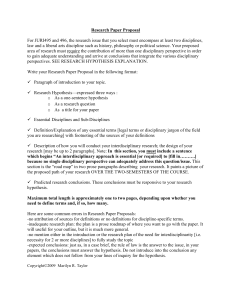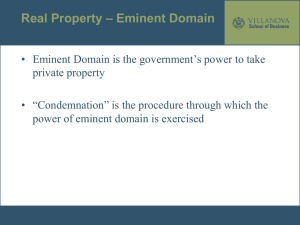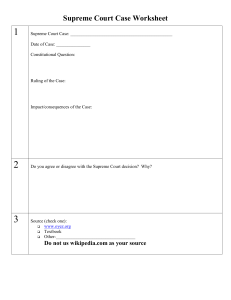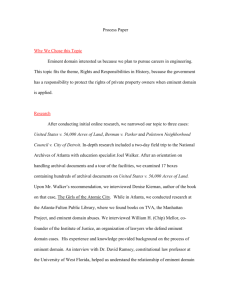3. Research Paper Proposal with student samples
advertisement
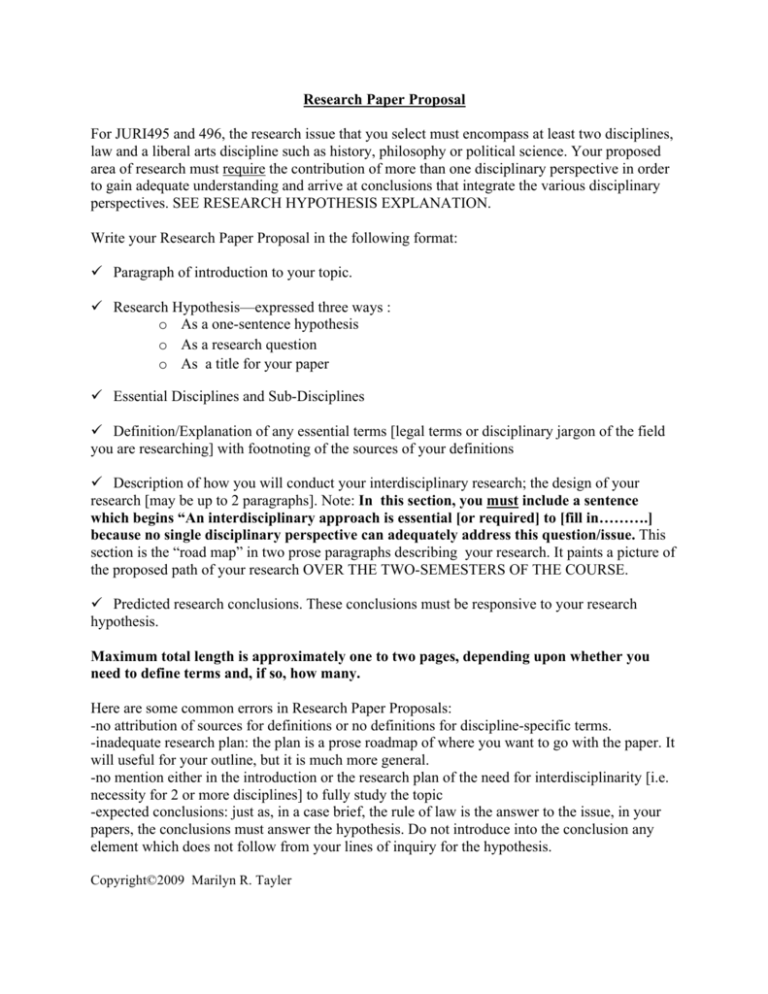
Research Paper Proposal For JURI495 and 496, the research issue that you select must encompass at least two disciplines, law and a liberal arts discipline such as history, philosophy or political science. Your proposed area of research must require the contribution of more than one disciplinary perspective in order to gain adequate understanding and arrive at conclusions that integrate the various disciplinary perspectives. SEE RESEARCH HYPOTHESIS EXPLANATION. Write your Research Paper Proposal in the following format: Paragraph of introduction to your topic. Research Hypothesis—expressed three ways : o As a one-sentence hypothesis o As a research question o As a title for your paper Essential Disciplines and Sub-Disciplines Definition/Explanation of any essential terms [legal terms or disciplinary jargon of the field you are researching] with footnoting of the sources of your definitions Description of how you will conduct your interdisciplinary research; the design of your research [may be up to 2 paragraphs]. Note: In this section, you must include a sentence which begins “An interdisciplinary approach is essential [or required] to [fill in……….] because no single disciplinary perspective can adequately address this question/issue. This section is the “road map” in two prose paragraphs describing your research. It paints a picture of the proposed path of your research OVER THE TWO-SEMESTERS OF THE COURSE. Predicted research conclusions. These conclusions must be responsive to your research hypothesis. Maximum total length is approximately one to two pages, depending upon whether you need to define terms and, if so, how many. Here are some common errors in Research Paper Proposals: -no attribution of sources for definitions or no definitions for discipline-specific terms. -inadequate research plan: the plan is a prose roadmap of where you want to go with the paper. It will useful for your outline, but it is much more general. -no mention either in the introduction or the research plan of the need for interdisciplinarity [i.e. necessity for 2 or more disciplines] to fully study the topic -expected conclusions: just as, in a case brief, the rule of law is the answer to the issue, in your papers, the conclusions must answer the hypothesis. Do not introduce into the conclusion any element which does not follow from your lines of inquiry for the hypothesis. Copyright©2009 Marilyn R. Tayler Caution: These samples represent student work products and may contain errors. Sample Student Research Proposals 2008-2009 Senior Seminar Dorothy Kenney JURI 495 Dr. Tayler Introduction The Second Amendment has been an issue of political and social debate. The ambiguity regarding the intent and its application explains the Supreme Court’s reluctance to take up the issue as it applies to state laws. The Supreme Court up until recently has refused to grant writ of certiorari since 1939. This past term, in District of Columbia v. Heller, the Supreme Court held by a one vote margin, for the first time in the nation’s history that the Second Amendment protects an individual’s right, unrelated to military service, to keep and bear arms. This precedent will open the door to future cases of selective incorporation of the Second Amendment as a fundamentally protected right of an individual. Research Hypothesis It is hypothesized that, subsequent to District of Columbia v. Heller, the United States Supreme Court has laid the foundation to uphold an individual’s Second Amendment “right to bear arms” under state law. Discipline: Law (Sub Discipline: Constitutional Law) Second Discipline: Political Science (Sub Discipline: American Government, Political Theory) Definitions • Second Amendment- A well regulated Militia being necessary to the security of a Free State; the right of the people to keep and bear Arms shall not be infringed.1 • Selective Incorporation- The process by which certain of the guarantees expressed in the Bill of Rights become applicable to the states through the Fourteenth Amendment2 Research Plan An interdisciplinary approach is essential to the study of Second Amendment rights because no single disciplinary perspective can adequately address this issue. The research will be used to analyze the historical intent and interpretation of the Constitution along with the political agendas underlying this debate. I will research the writings and ideas of influential jurists and political theorist and understand their perspectives with gun possession as a “right” or a 1 U.S. Const. amend. II 2 Black’s Law Dictionary, 3rd ed. 1996 “privilege”. The research will then extend beyond historical perspectives and incorporate the origins of the Second Amendment and show the effects on federal and state laws regulating guns. This will also be used to address the effects of prior court decisions and how they have applied to Second Amendment rights. Furthermore, I will examine the role of public opinion and interest groups in influencing legislation, and the future implication that the Heller case will have on gun rights in America. I will also approach the issue through a jurisdictional perspective and how the Heller case compares to past precedent and questions of selective incorporation. Expected Conclusions It is anticipated that in response to the Heller case, the Supreme Court will now need to decide whether Second Amendment rights can be applied to state governments by incorporation through the Fourteenth Amendment. The outcome of recent judicial interpretations will change the landscape of Second Amendment protection for all American citizens. Copyright©2009 Dorothy Kenney Statement of Research Christine Aramini JURI 495 Dr. Tayler Due: 10/20/08 Introduction: The Takings Clause of the Fifth Amendment of the United States Constitution holds that “[no person shall] be deprived of life liberty, or property, without due process of law; nor shall private property be taken for public use, without just compensation.” An individual’s right to property is one of the fundamental rights on which this nation was built. Nevertheless, in 2005 the United States Supreme Court found in the case Kelo v. New London that “public use,” includes private economic development in order to generate more tax revenue for the local government. Homeowners in New London, Connecticut attempted to stop the city from taking their homes to make way for private development including a hotel complex and condominiums. The outcome of this case has elicited much controversy and outrage over the topic of eminent domain and what exactly is constituted as a “public good.” Research Hypothesis: It is hypothesized that current law regarding eminent domain transfers property rights to private enterprises without consideration of “the public good.” Disciplines: Law: Law of Eminent Domain [focusing on Supreme Court Ruling/ Current NJ State Law] Political Science: [Constitutional Law/ American Government and Politics/ State and Local Government] Sociology: [Political Sociology] Definitions: Eminent domain: a right of a government to take private property for public use by virtue of the superior dominion of the sovereign power over all lands within its jurisdiction.3 Blight: a deteriorated condition. (As in urban blight). 4 Lobby: to promote (as a project) or secure the passage of (as legislation) by influencing public officials; to attempt to influence or sway (as a public official) toward a desired action.5 Police power: the inherent power of a government to exercise reasonable control over persons and property within its jurisdiction in the interest of the general security, health, safety, morals, and welfare except where legally prohibited.6 Research Plan: I plan to explore the politics involved in eminent domain cases as well as abuse of the eminent domain ruling. An interdisciplinary approach is essential to explore this problem because no single disciplinary perspective can adequately address the issue of eminent domain. I will conduct my research by examining the issue through the disciplines of Political Science and Law. I would like to outline the history of eminent domain law up to the present. I will employ political theories on the topic of property rights, such as those of John Locke. I will include in my research lobbyist groups for eminent domain as well as interest groups which have impacted the law. I will also look into elected public officials that have favored private enterprises over personal property rights concerning this issue. The term “public good,” found in the ruling is very vague and leaves a lot of room for different interpretations. I plan to explore various cases following the eminent domain ruling especially as applied in the State of New Jersey. 3 Merriam‐Webster Online Dictionary, s.v. “eminent domain,” http://www.merriam‐webster.com/dictionary/ (accessed October 5, 2008). 4 Ibid., sv. “blight.” 5 Ibid., s.v. “lobby.” 6 Ibid. s.v. “police power.” Expected Conclusions: Since Kelo v. New London has broadened the term “public good” this has been used to the advantage of private enterprises. I also expect to find that much of the abuse of the ruling occurs in lower income areas and that local politics has a great bearing on where individual cases arise. Copyright©2009 Christine Aramini
